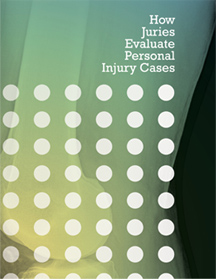Anticipating and meeting defenses in sexual harassment and employment discrimination cases
Explain why plaintiff stayed in the environment
In most sexual harassment cases or employment discrimination cases, the defense will take the position that the harassment or discrimination must not have been that bad or did not occur at all because plaintiff remained in the “hostile environment” for a significant period of time.
If you are the plaintiff in a sexual harassment or employment discrimination case, there are usually two ways for your mental health injury attorney to counter this defense:
- Factually, by explaining why you could not afford to leave the position.
- Psychologically, by explaining, through an expert witness, why you were unable to adequately protect yourself and stand up to the perpetrator or escape the hostile environment.
The factual explanation is normally straightforward and based upon simple economics in the job market. If you (or you and your family) are living month to month and financially dependent upon your salary, it is very difficult for you to voluntarily leave your place of employment, particularly if it means that you will only be out of work for a few months or longer. This explanation is strengthened if there was a poor job market at the time and it would have been difficult for you to get another job with equivalent pay.
The psychological reasons for you continuing to work in a hostile environment are normally more subtle and complex and will require the testimony of a psychological expert.
For instance, in a sexual harassment case in which plaintiff remains in a hostile work environment, it may turn out that plaintiff was sexually abused as a child and was told by her abuser that great harm would come to her if she reported the molestation. Plaintiff’s psychological expert may be able to explain that under these circumstances plaintiff was not able to motivate herself to take the risk of reporting the abuse, rationally or irrationally fearing that great harm would come to her.
In the same situation, if the issue is why plaintiff did not leave the job as opposed to reporting the abuse, it may turn out that plaintiff grew up with a very low sense of self-esteem based upon verbal abuse by parents who convinced plaintiff that she was no good because she always “gave up on situations.” Thus, under these circumstances, unconsciously, plaintiff may have been psychologically unable to handle the additional loss of self-esteem that would occur if she “quit” her employment, which would confirm the worst fears about herself, instilled in her by poor parenting.
Defense that harassment was not severe and pervasive
In most cases the defense will argue that, even assuming plaintiff’s harassment claim is accurate, the harassment that he or she had to endure was not “severe or pervasive.”
The deposition preparation of plaintiff will be critical in overcoming the defense that the harassment was not severe or pervasive. If you are the plaintiff in a sexual harassment case, your plaintiff’s attorney must prepare you to be truthful and to testify to all the facts that reveal that the harassment was severe or pervasive.
Let’s look at some examples, which are not uncommon. Suppose that when you initially report harassment to your employer, you report multiple incidents of harassment taking place over a long period of time. Then your employer chooses to focus on just one or two incidents for its investigation. All of a sudden, the case becomes about these one or two incidents, and the pervasive nature of the harassment is ignored. This same phenomenon can occur more innocently in a situation in which you only report one or two significant incidents of harassment and you are never asked by your employer about other behavior that you found offensive.
In either situation, and even in cases where there has never been an investigation by an employer, your deposition will be critical to fill in the gaps. During deposition preparation, your mental health injury attorney should advise you that it is important that you relate each and every incident that you feel was harassing, unwelcome or created a hostile work environment. You may have been hesitant to reveal acts of harassment, such as the perpetrator staring at you every day, because you might have felt that this made you sound conceited or “silly.” Your mental injury plaintiff’s attorney must help you get over this fear. You need to be prepared to testify about all episodes of harassing conduct, even if the defense attorney raises his or her eyebrows during questioning.
As to establishing “pervasiveness,” your deposition is, again, the key. Under the law, pervasiveness is determined from the “totality of the circumstances.” Therefore, your personal injury attorney must prepare you to testify about the appropriate “context” under which you had to endure harassment.
For instance, it is one thing for a plaintiff to simply testify, “My supervisor grabbed my butt.” It is quite another for plaintiff to testify, “My supervisor has been telling me for weeks that if I refuse to go out with him he would grab my butt in front of all of my co-employees. In fact, he waited until I walked into a meeting late, where all of my co-employees were looking at me before he grabbed my butt and then laughed and tried to get everybody else to laugh along with him.” During deposition, it is vital that plaintiff relate all the episodes of harassment, including the context for each one.
Importance of proving pretext
In employment discrimination litigation, a key issue is disparate treatment. The employer will bear the burden of articulating a “legitimate, non-discriminatory reason” for treating plaintiff differently than other employees are treated. If the employer can articulate a legitimate, non-discriminatory reason for the disparate treatment, then the burden of proof shifts to plaintiff to prove that the employer’s stated reason is merely a “pretext” to mask an unlawful discriminatory motive.
To establish pretext, the plaintiff’s attorney can offer evidence like one or more of the following:
- Statements made by managers that indicate a discriminatory motive in taking the adverse employment action against plaintiff. Examples:
- In an age discrimination case a statement like “You are too slow and old to continue to work at your job.”
- In a race discrimination case a statement like “This is work best suited for white people.”
- Circumstantial evidence of disparate treatment. Example: in a gender discrimination case, firing a woman for participating in the exact same conduct as five male employees who were not disciplined or fired.
- Statistical evidence. Example: in an age discrimination case, evidence that in a large company with thousands of employees no employee over age 50 had ever been promoted to a certain level management position despite proof that many such employees had applied.



